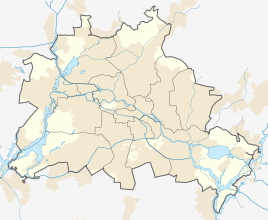Julius Leber Barracks (Berlin)
|
|
|||
|---|---|---|---|

Main building of the barracks |
|||
| country | Germany | ||
| Earlier |
Headquarters of the Forces Françaises à Berlin |
||
| local community | Berlin-Wedding | ||
| Coordinates : | 52 ° 34 ' N , 13 ° 19' E | ||
| Opened | 1936-1939 | ||
| Stationed troops | |||
|
WachBtl BMVg Feldjägerregiment 1 Command Territorial Tasks of the Bundeswehr Staff Music Corps of the Bundeswehr Regional Security and Support Company Berlin |
|
||
| Old barracks names | |||
| 1896-1936 1936-1945 1945-1994 |
Barracks Reinickendorf Hermann Göring barracks Quartier Napoléon |
|
|
| Formerly stationed units | |||
|
Parachute Panzer Division 1 Infantry Regiment 46, 11th Jägerregiment, Location Command Berlin |
|
||
|
Location of the Julius-Leber-Kaserne in Berlin |
|||
The Julius Leber barracks in Berlin district of Wedding is the largest barracks of the Bundeswehr in the German capital. The barracks is located directly southeast of Tegel Airport and is bordered by Kurt-Schumacher-Damm and Charles-Corcelle-Ring. The barracks is named after the SPD politician and resistance fighter Julius Leber and is a listed building .
history
The Jungfernheide area was already used for military purposes in the 19th century. In 1896, the world's first regular air force unit, an airship battalion, was set up here and housed in barracks. After the end of the First World War , the German Reich was prohibited from maintaining air forces in the Treaty of Versailles . From 1928 the area was used by the police and the airship hangars were demolished.
From 1936 to 1939 a spacious barracks was built on the site for the Infantry Regiment “General Göring” of the Luftwaffe (later: Parachute-Panzer Division 1 Hermann Göring ) formed from the state police . The design came from Oberbaurat Schneidt and envisaged 130 buildings arranged around a central axis. There is also a sports facility with a running track and outdoor swimming pool on the site. The triangular site is accessed by an oval ring road, the narrower end of which points to the entrance building on the northeast corner of the site.
After the unconditional surrender of the Wehrmacht and the Allied occupation of Berlin, the French army set up the "Quartier Napoléon" as the headquarters of the Forces Françaises à Berlin from August 1945 . From 1945 to 1955 they restored the facility, which had been badly damaged by the war and the occupation by the Red Army . The French built the Cité Joffre residential complex south of the complex . An air force command was stationed in the Napoléon quarter from 1945 to set up Tegel Airport as a French military airfield . In 1947 the 46th Infantry Regiment and in 1955 the 11th Jägerregiment were added. According to their mission, both units were specialized in urban combat and anti-tank defense. Other French units in the barracks were pioneers , a supply battalion and the military gendarmerie, which also served at the sector border . The French military broadcaster Radio ffb also broadcast from the “Quartier Napoléon”, mostly as a relay station and without its own editorial team.
After the withdrawal of the Allied troops, the Bundeswehr took over the site in 1994. On January 5, 1995, the 50th anniversary of the death of Julius Leber barracks in the presence of was former Chancellor Helmut Schmidt , the daughter of Julius Leber and the then Federal Minister of Defense Volker Ruhe in Julius Leber Barracks renamed.
Location
The guard battalion of the Federal Ministry of Defense and the Feldjägerregiment 1 are currently stationed at the site. Following the dissolution of the Berlin site command as the former state command for Berlin, the Bundeswehr's Territorial Tasks Command has taken over its headquarters and tasks here. The Berlin Bundeswehr service center is also housed in the barracks, as is the guest house of the Federal Minister of Defense .
The Julius-Leber-Kaserne is also the alternative seat of the Federal Chancellery in the event that the property currently in use cannot be used.
Web links
- Entry in the Berlin State Monument List
- Quartier Napoleon - on the history of the French location (French)
Individual evidence
- ^ Friedrich Jeschonnek: Allies in Berlin 1945-1994. BWV Verlag, 2007, ISBN 978-3-830-50397-2 , p. 483 ( limited preview in Google book search).
- ↑ Au revoir, Tegel! In: Der Tagesspiegel , April 28, 2012
- ^ Army Francaise. At: alliierteinberlin.de
- ^ Matthias Donath: Architecture in Berlin 1933–1945. Ed. from the Landesdenkmalamt Berlin, Lukas Verlag, Berlin 2007, ISBN 3-936872-26-0 , pp. 87-92.
- ↑ a b Gerhild HM Komander: The Wedding. Berlin Story Verlag, Berlin 2006, ISBN 392982938X , pp. 209-212.
- ↑ The Radionauten: Radio Stories: Time travel and excursions to the Berlin Radio worlds. Berlin 2005, ISBN 3833424389 , pp. 40-41.
- ↑ Der Spiegel No. 41, October 8, 2016, p. 38.





